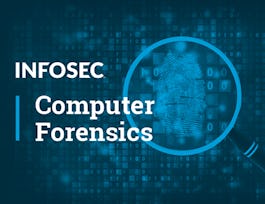The Windows Registry Forensics course shows you how to examine the live registry, the location of the registry files on the forensic image, and how to extract files.


Windows Registry Forensics
This course is part of Computer Forensics Specialization
Taught in English
Some content may not be translated

Instructor: Denise Duffy
3,719 already enrolled
Included with 
Course
(40 reviews)
Details to know

Add to your LinkedIn profile
1 quiz
Course
(40 reviews)
See how employees at top companies are mastering in-demand skills

Build your subject-matter expertise
- Learn new concepts from industry experts
- Gain a foundational understanding of a subject or tool
- Develop job-relevant skills with hands-on projects
- Earn a shareable career certificate


Earn a career certificate
Add this credential to your LinkedIn profile, resume, or CV
Share it on social media and in your performance review

There are 8 modules in this course
Discover what the Windows Registry is and why it is important in digital forensic investigations. This module will explore the location and structure of the registry hives in a live and non-live environment, as well as the types of forensic evidence found in the Windows Registry. This will include: user account information, system-wide and user-specific settings, file access, program installation and execution, search terms, auto-start locations and devices attached to the system. Please use the links and tools provided in the two reading sections to get the URLs and other downloads you will need for the course.
What's included
2 videos3 readings
Learn how to set up a forensic workstation to properly examine the Windows Registry. This module takes a look at the location of the Registry files within the Windows OS and the many tools freely available to view the file structure and artifacts contained within the Windows Registry. It includes instruction on the installation, proper use and validation of your forensic software, showing how to get the most out of your automated tools while maintaining an understanding of what the tool is doing behind the scenes.
What's included
4 videos
This module demonstrates an in-depth analysis of the artifacts contained within the NTUser.Dat hive file. This module will show examiners how to locate programs and applications, mounted volumes and connected devices specific to a user, user search terms and typed URLs. Examiners will also be able to locate and identify opened and saved files, typed URLs, user-specific programs set to run at startup and application installation and execution. Examiners will be able to locate, examine and interpret MRU lists (Most Recently Used), UserAssist, user system settings and recently used files.
What's included
9 videos
This module explains forensic artifacts found in the SAM (Security Account Manager) file, which stores and organizes information about each user on a system. This module demonstrates how to identify each user account on a local machine using the relative identifier. Examiners can also learn to interpret username information including the users’ login dates, times and login count. The module will show how to identify the machine that the user account was created on, by interpreting a users’ SIDs (machine/domain identifiers) and recovering user password hashes.
What's included
5 videos
This module will show examiners how to locate information of forensic value relating to application execution and installation contained within the software hive file. The module will provide an overview of the forensic artifacts found in the software hive file, such as installed programs and applications, operating system type, install date and time, wireless network information, file association, domain logon information, the last logged-on user, programs set to run at startup and tracking USB devices that were attached to the system.
What's included
3 videos
This module will demonstrate evidence of forensic value contained within the system hive file. This module explores the system hive file showing how to determine the current control set, computer name, last shutdown date and time, crash dump settings and location, services set to run at startup, page file settings, prefetch settings, last access file time settings, AppCompat Cache, BAM (background activities monitor) and USB device connections and disconnections with dates and times.
What's included
3 videos
This module identifies and explains forensic artifacts found in the UsrClass.dat hive file. This module will look at the UsrClass.dat hive. The examiner will learn to explain Windows ShellBags, which track user-specific zip files and folder access and settings, including dates and times even on deleted folders and removable media. The examiner will also learn to interpret the sub-key MuiCache, to include installed applications. The Microsoft Photo App, showing recently accessed image files, will also be explored.
What's included
2 videos
This module will examine the AmCache hive file, which stores information relating to the execution of applications. A forensic examination of the AmCache hive file showing the following: application installation, application first run date and time, a file path to the executable file, the source of the application, a SHA-1 hash value of the executable file, plug-and-play connected devices, GUIDs of mounted volumes and system hardware information.
What's included
2 videos1 quiz
Instructor

Offered by
Recommended if you're interested in Security
Why people choose Coursera for their career




Learner reviews
Showing 3 of 40
40 reviews
- 5 stars
82.50%
- 4 stars
15%
- 3 stars
2.50%
- 2 stars
0%
- 1 star
0%
New to Security? Start here.

Open new doors with Coursera Plus
Unlimited access to 7,000+ world-class courses, hands-on projects, and job-ready certificate programs - all included in your subscription
Advance your career with an online degree
Earn a degree from world-class universities - 100% online
Join over 3,400 global companies that choose Coursera for Business
Upskill your employees to excel in the digital economy
Frequently asked questions
Access to lectures and assignments depends on your type of enrollment. If you take a course in audit mode, you will be able to see most course materials for free. To access graded assignments and to earn a Certificate, you will need to purchase the Certificate experience, during or after your audit. If you don't see the audit option:
The course may not offer an audit option. You can try a Free Trial instead, or apply for Financial Aid.
The course may offer 'Full Course, No Certificate' instead. This option lets you see all course materials, submit required assessments, and get a final grade. This also means that you will not be able to purchase a Certificate experience.
When you enroll in the course, you get access to all of the courses in the Specialization, and you earn a certificate when you complete the work. Your electronic Certificate will be added to your Accomplishments page - from there, you can print your Certificate or add it to your LinkedIn profile. If you only want to read and view the course content, you can audit the course for free.
If you subscribed, you get a 7-day free trial during which you can cancel at no penalty. After that, we don’t give refunds, but you can cancel your subscription at any time. See our full refund policy.





